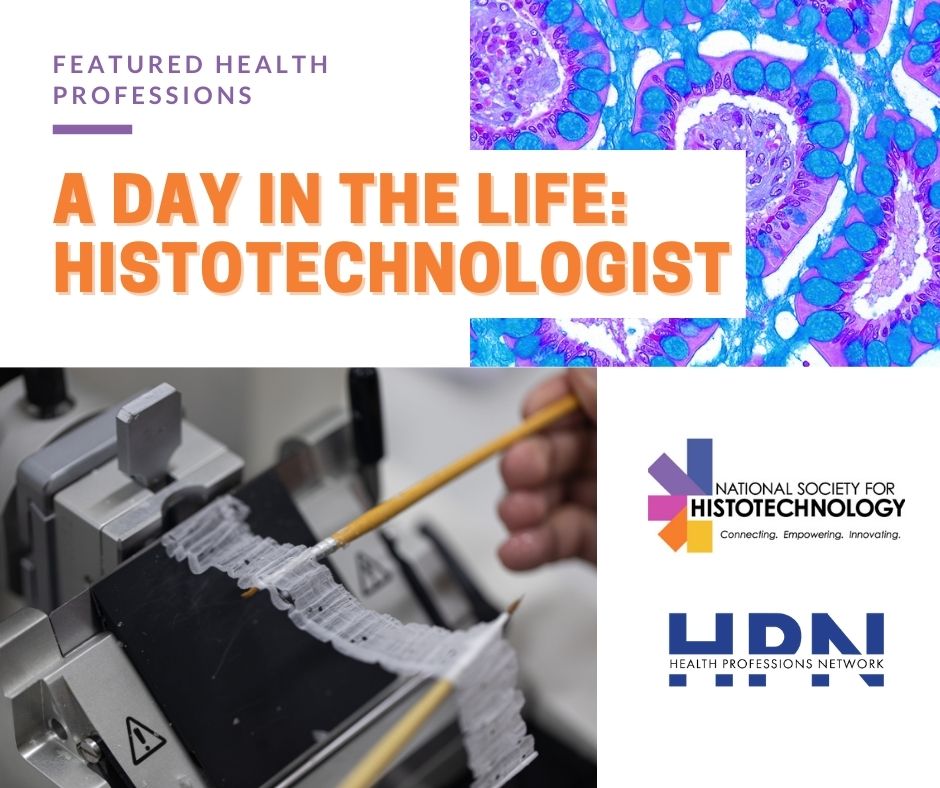This blog is the fourth in a series of profiles of different clinical health professions represented by Health Professions Network member organizations. These profiles are intended to give students and those looking at prospective careers in health care an accurate, professional perspective on different health care fields, specialties and careers. "A Day in the Life of a Histotechnologist" was developed by the National Society for Histotechnology (NSH), an HPN member organization.
Table of Contents
- What is a Histotechnologist?
- Rewards of Being a Histotechnologist
- Becoming a Histotechnologist
- Salary & Professional Outlook for Histotechnologists

What is a Histotechnologist?
Histotechnology is a science centering on the microscopic detection of tissue abnormalities for disease diagnosis and treatment. Utilizing specific reagents, chemicals, and dyes, the Histotechnologist prepares surgical specimens for microscopic screening by the surgical pathologist. This knowledge of chemical reactions, combined with an understanding of tissue composition, allows the Histotechnologist to stain the tissue in a way that differentiates distinct tissue and cellular structures. The difference in these tissue cells' appearance under a microscope allows a pathologist to ultimately render a clinical diagnosis and guides treatment options for the patient.
In the modern histology lab, immunohistochemistry (IHC), digital pathology, and molecular (DNA/RNA) techniques are frequently utilized to provide accurate tumor identification, which will help the clinician select a treatment strategy that offers the greatest probability of a cure.
Histotechnologist Work Environments
Histotechnology is a diverse field that offers numerous avenues for people in this profession to pursue based on their interests.
- Hospitals: Histotechnologists often work in the local community and large metropolitan hospitals with an in-house department of pathology.
- Reference Laboratories: Reference labs provide histology services for various external clients, including clinical trial requests, veterinary offices, scientific studies, doctors' offices, hospitals, etc. Large reference labs are emerging in the research area in the form of Laboratory Developed Tests.
- Academic and Research Facilities: On the cutting edge of histology, academic hospitals and universities work on immunology, antitumor immunity, molecular diagnostics, microbial pathogenesis, antigen selection, t-cell development, and more.
- Pharmaceutical Companies: Histotechnologists play a vital role in developing drugs designed to treat the diseases their profession identifies. Knowing how tissues and antibodies respond to various chemicals is essential in determining whether a treatment will be effective.
- Government Agencies: Histotechnologists employed by the government include the Centers for Disease Control and Prevention, the Federal Drug Administration, National Institutes of Health, the United States Department of Agriculture and various state Bureaus of Investigation.
- Industry: Examples of industries that employ Histotechnologists include biomedical, veterinary labs, food production, paper processing, and tire manufacturing.
- MOHS Surgery Clinics: Dermatology clinics that diagnose and treat common skin cancers.

Rewards of Being a Histotechnologist
Histotechnology is a profession that people generally stumble into, but once they find it, they're in love. They are invisible heroes. Histotechnologists are drawn to the field because of their strong interest in patient care. They want to make a difference in people's lives and work in healthcare but don't thrive on the direct patient contact that is seen by a nurse or doctor. They play a vital role behind the scenes, performing the tasks necessary to bridge the gap between collecting a specimen and patient diagnosis and possible treatment.
Besides the rewards of being an essential part of patient treatment, Histotechnologists find their diverse interests fulfilled in the profession, making it intrinsically rewarding. Many are drawn to the field specifically because it combines science with art, allowing Histotechnologists to express both the creative and logical sides of their brain. The stains that ultimately lead to diagnosis are also often very visually striking. Colorful, detailed tissue structures are illuminated through chemical dyes, while immunofluorescent techniques produce stunning neon pictures. These pictures could almost belong in an art gallery. In fact, histology art is prevalent on Instagram and even sold in prints, t-shirts, and these days, masks.
Becoming a Histotechnologist
Histotechnologists are certified through the American Society for Clinical Pathology. To qualify for the HT certification exam, an aspiring Histotechnologist can either attend an accredited histology program, which is offered at various colleges, as well as online universities, or they can train on the job, with a two-year degree that includes chemistry, biology, and mathematics credits. For those who wish to further their knowledge and expertise, an aspiring Histotechnician may pursue their HTL certification. The HTL is an advanced-level certification that allows the holder to perform high-complexity testing, such as performing gross examinations, IHC, and digital pathology. The HTL requires a bachelor's degree and either graduating from an accredited histology program or on the job training.
Histotechnology is a hands-on profession, requiring mastery of equipment, excellent manual dexterity, and practice staining tissue samples. Therefore all histology students are required to do a clinical rotation, where they learn these hands-on skills. Their in-class education is also essential to provide the proper background knowledge on chemical composition, types of tissues, and biological responses, so they understand the theory behind their work. Once certified, Histotechnologists and Histotechnicians maintain their certification by completing 36 hours of continuing education every three years to ensure their skills are up to date and high patient care standards. Many Histotechnologists and Histotechnicians take advantage of the self-paced courses and on-demand webinars offered by the National Society for Histotechnology (NSH). The on-demand webinars are histology focused and approved for ASCP, PACE, and CE Broker continuing education credits and may be tracked through NSH's CE Tracker upon establishment of an NSH account, providing individuals with an easy way to keep up with the credits they need for recertification.
Once in the profession, they can pursue additional qualifications in specific areas, such as IHC and Laboratory Safety. Requirements for Histotechnologists can vary from state to state, with several states such as Florida, Nevada, and New York requiring additional state licensure.
Salary Information
Histotechnology salaries vary by region, type of laboratory, and the degree or certification held by the individual. According to the most recent Laboratory Workforce Report, published in 2019 and conducted by the American Society for Clinical Pathology with input from NSH members, the average hourly wage for a staff level Histotechnologist is $26.96, while the average hourly wage for an Histotechnician is $29.12. The average hourly wage for a supervisor level Histotechnologist is $31.45 and $34.04 for a Histotechnician.

